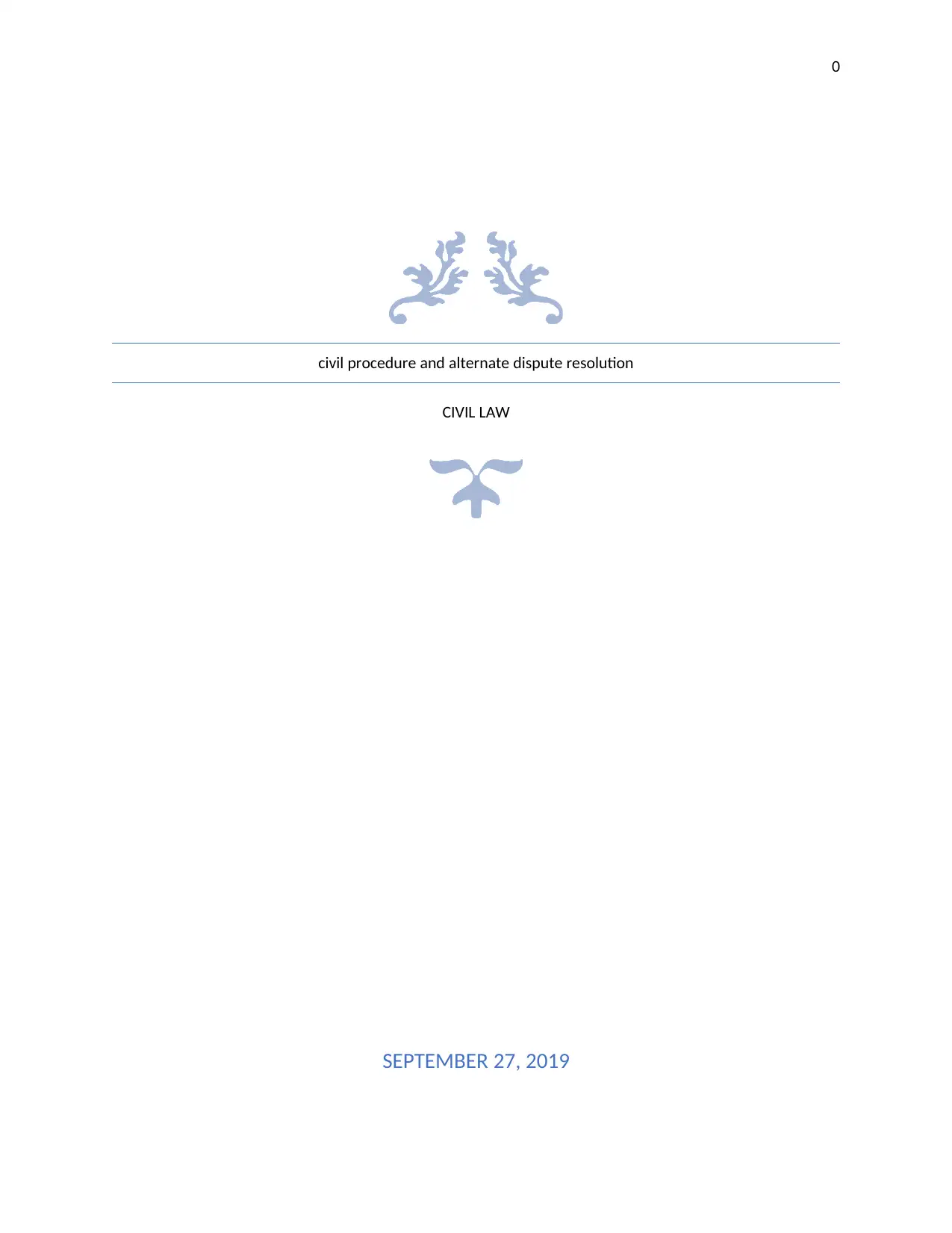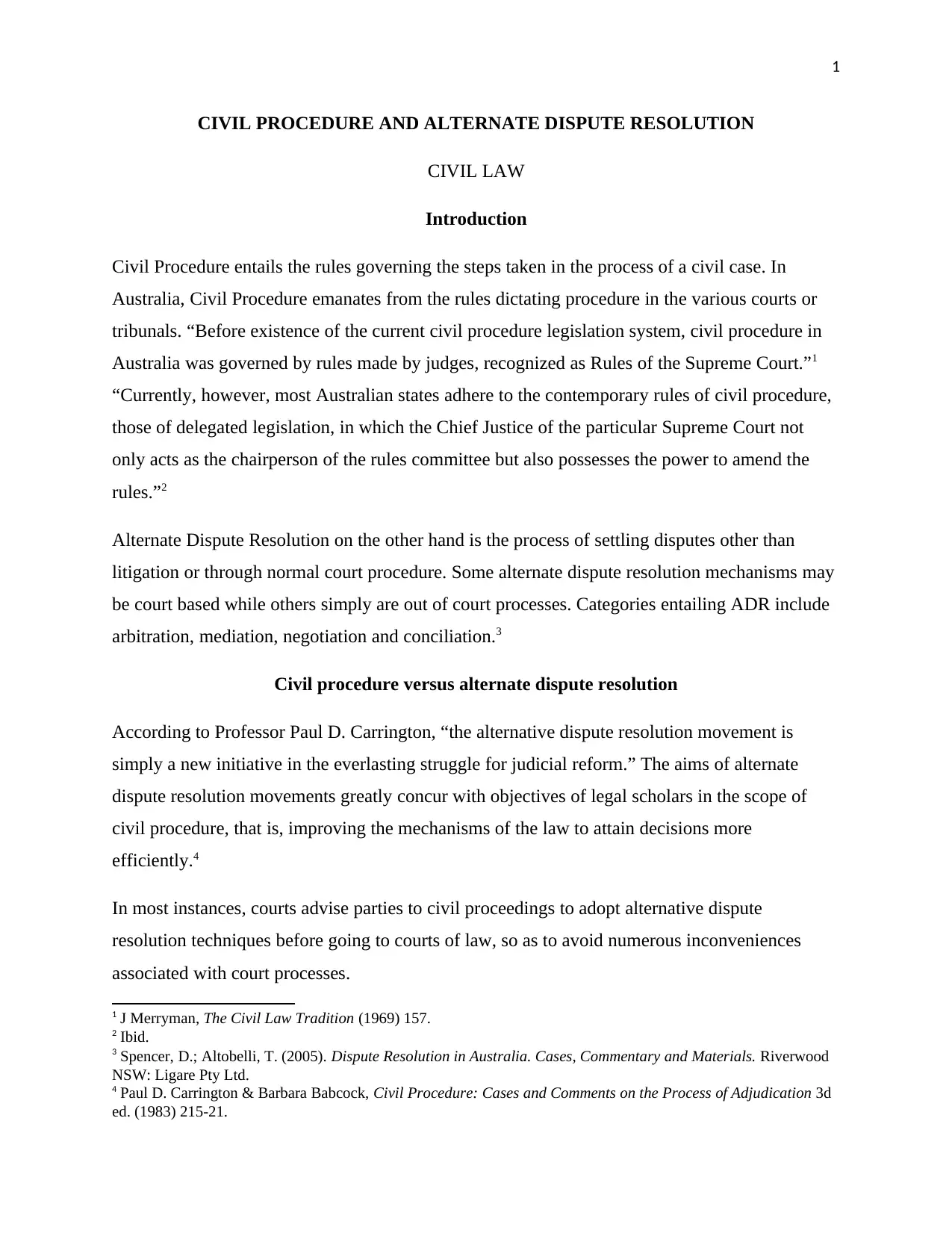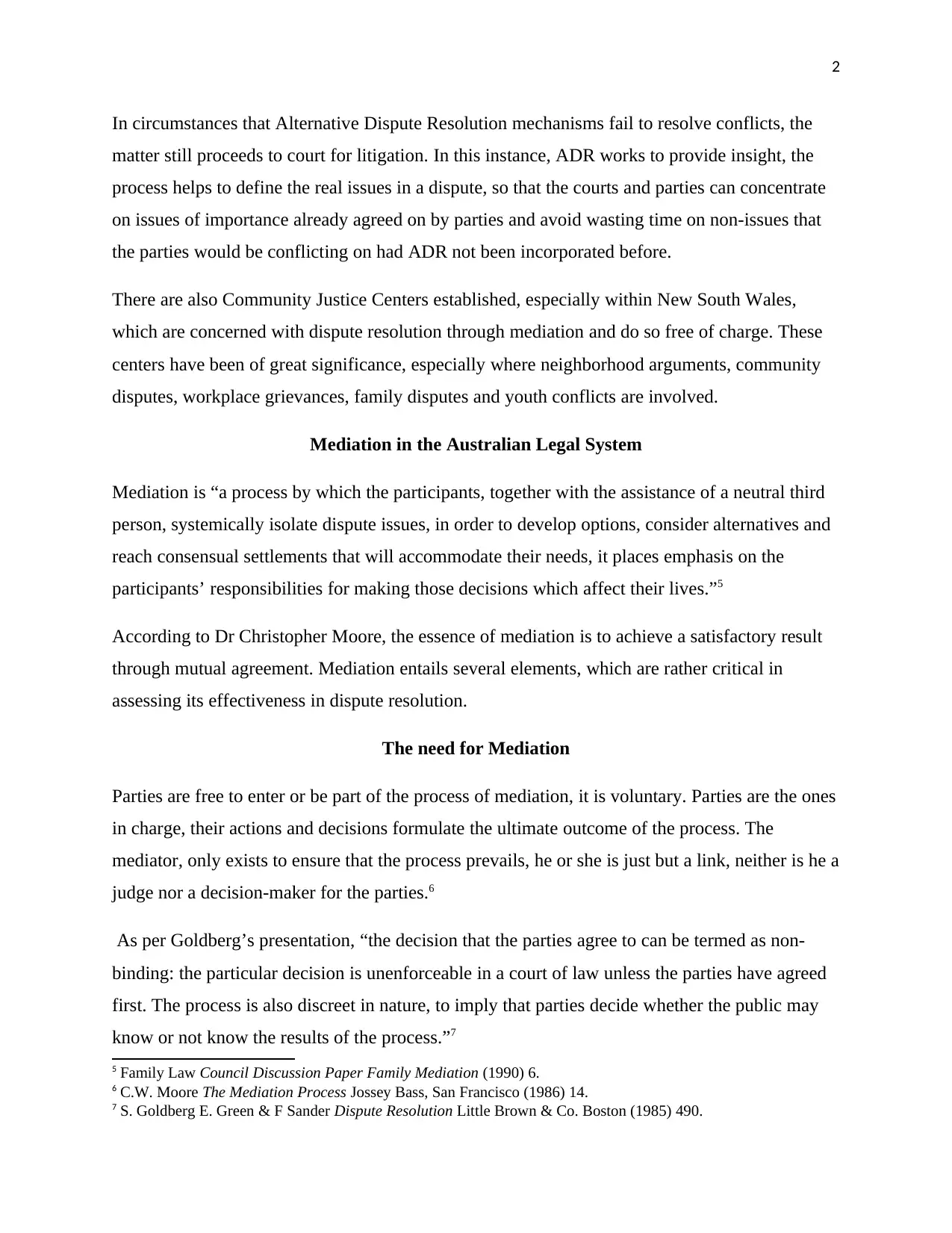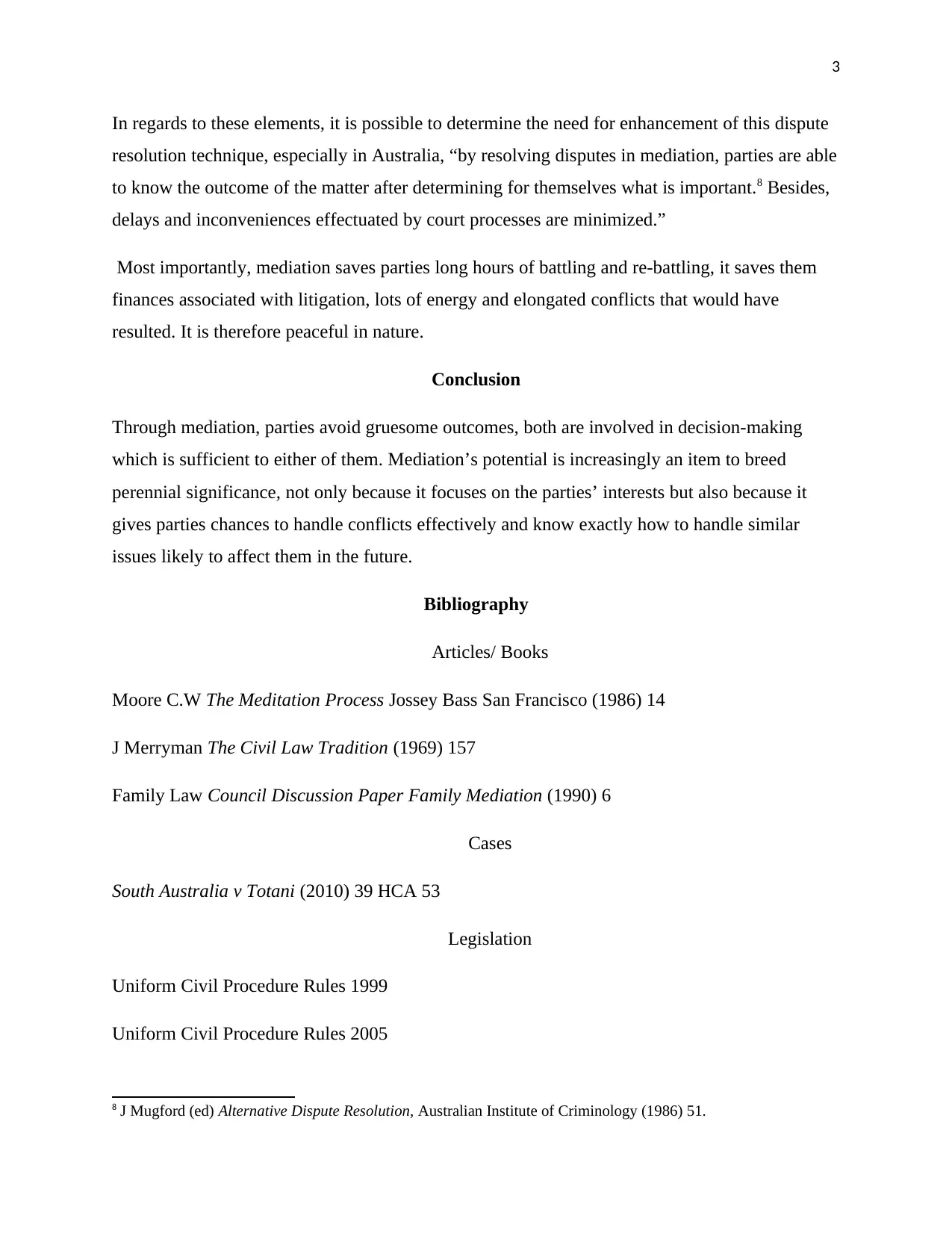Civil Procedure and Alternate Dispute Resolution in Australian Law
VerifiedAdded on 2022/10/09
|4
|909
|17
Report
AI Summary
This report delves into the realms of civil procedure and alternate dispute resolution (ADR) within the Australian legal system. It begins by defining civil procedure and its roots in court rules, contrasting it with ADR mechanisms like arbitration, mediation, negotiation, and conciliation. The report highlights the convergence of ADR and civil procedure goals, emphasizing the efficiency of resolving disputes. It then explores the use of mediation, particularly in New South Wales' Community Justice Centers, and details the elements of mediation, including its voluntary nature, party control, the role of the mediator, and its confidential nature. The report underscores the benefits of mediation in terms of party satisfaction, reduced delays and costs, and the promotion of peaceful resolutions. It concludes by emphasizing mediation's growing significance in focusing on parties' interests and providing them with tools to handle future conflicts effectively, supported by a bibliography of relevant articles, books, cases, and legislation.

0
civil procedure and alternate dispute resolution
CIVIL LAW
SEPTEMBER 27, 2019
civil procedure and alternate dispute resolution
CIVIL LAW
SEPTEMBER 27, 2019
Paraphrase This Document
Need a fresh take? Get an instant paraphrase of this document with our AI Paraphraser

1
CIVIL PROCEDURE AND ALTERNATE DISPUTE RESOLUTION
CIVIL LAW
Introduction
Civil Procedure entails the rules governing the steps taken in the process of a civil case. In
Australia, Civil Procedure emanates from the rules dictating procedure in the various courts or
tribunals. “Before existence of the current civil procedure legislation system, civil procedure in
Australia was governed by rules made by judges, recognized as Rules of the Supreme Court.”1
“Currently, however, most Australian states adhere to the contemporary rules of civil procedure,
those of delegated legislation, in which the Chief Justice of the particular Supreme Court not
only acts as the chairperson of the rules committee but also possesses the power to amend the
rules.”2
Alternate Dispute Resolution on the other hand is the process of settling disputes other than
litigation or through normal court procedure. Some alternate dispute resolution mechanisms may
be court based while others simply are out of court processes. Categories entailing ADR include
arbitration, mediation, negotiation and conciliation.3
Civil procedure versus alternate dispute resolution
According to Professor Paul D. Carrington, “the alternative dispute resolution movement is
simply a new initiative in the everlasting struggle for judicial reform.” The aims of alternate
dispute resolution movements greatly concur with objectives of legal scholars in the scope of
civil procedure, that is, improving the mechanisms of the law to attain decisions more
efficiently.4
In most instances, courts advise parties to civil proceedings to adopt alternative dispute
resolution techniques before going to courts of law, so as to avoid numerous inconveniences
associated with court processes.
1 J Merryman, The Civil Law Tradition (1969) 157.
2 Ibid.
3 Spencer, D.; Altobelli, T. (2005). Dispute Resolution in Australia. Cases, Commentary and Materials. Riverwood
NSW: Ligare Pty Ltd.
4 Paul D. Carrington & Barbara Babcock, Civil Procedure: Cases and Comments on the Process of Adjudication 3d
ed. (1983) 215-21.
CIVIL PROCEDURE AND ALTERNATE DISPUTE RESOLUTION
CIVIL LAW
Introduction
Civil Procedure entails the rules governing the steps taken in the process of a civil case. In
Australia, Civil Procedure emanates from the rules dictating procedure in the various courts or
tribunals. “Before existence of the current civil procedure legislation system, civil procedure in
Australia was governed by rules made by judges, recognized as Rules of the Supreme Court.”1
“Currently, however, most Australian states adhere to the contemporary rules of civil procedure,
those of delegated legislation, in which the Chief Justice of the particular Supreme Court not
only acts as the chairperson of the rules committee but also possesses the power to amend the
rules.”2
Alternate Dispute Resolution on the other hand is the process of settling disputes other than
litigation or through normal court procedure. Some alternate dispute resolution mechanisms may
be court based while others simply are out of court processes. Categories entailing ADR include
arbitration, mediation, negotiation and conciliation.3
Civil procedure versus alternate dispute resolution
According to Professor Paul D. Carrington, “the alternative dispute resolution movement is
simply a new initiative in the everlasting struggle for judicial reform.” The aims of alternate
dispute resolution movements greatly concur with objectives of legal scholars in the scope of
civil procedure, that is, improving the mechanisms of the law to attain decisions more
efficiently.4
In most instances, courts advise parties to civil proceedings to adopt alternative dispute
resolution techniques before going to courts of law, so as to avoid numerous inconveniences
associated with court processes.
1 J Merryman, The Civil Law Tradition (1969) 157.
2 Ibid.
3 Spencer, D.; Altobelli, T. (2005). Dispute Resolution in Australia. Cases, Commentary and Materials. Riverwood
NSW: Ligare Pty Ltd.
4 Paul D. Carrington & Barbara Babcock, Civil Procedure: Cases and Comments on the Process of Adjudication 3d
ed. (1983) 215-21.

2
In circumstances that Alternative Dispute Resolution mechanisms fail to resolve conflicts, the
matter still proceeds to court for litigation. In this instance, ADR works to provide insight, the
process helps to define the real issues in a dispute, so that the courts and parties can concentrate
on issues of importance already agreed on by parties and avoid wasting time on non-issues that
the parties would be conflicting on had ADR not been incorporated before.
There are also Community Justice Centers established, especially within New South Wales,
which are concerned with dispute resolution through mediation and do so free of charge. These
centers have been of great significance, especially where neighborhood arguments, community
disputes, workplace grievances, family disputes and youth conflicts are involved.
Mediation in the Australian Legal System
Mediation is “a process by which the participants, together with the assistance of a neutral third
person, systemically isolate dispute issues, in order to develop options, consider alternatives and
reach consensual settlements that will accommodate their needs, it places emphasis on the
participants’ responsibilities for making those decisions which affect their lives.”5
According to Dr Christopher Moore, the essence of mediation is to achieve a satisfactory result
through mutual agreement. Mediation entails several elements, which are rather critical in
assessing its effectiveness in dispute resolution.
The need for Mediation
Parties are free to enter or be part of the process of mediation, it is voluntary. Parties are the ones
in charge, their actions and decisions formulate the ultimate outcome of the process. The
mediator, only exists to ensure that the process prevails, he or she is just but a link, neither is he a
judge nor a decision-maker for the parties.6
As per Goldberg’s presentation, “the decision that the parties agree to can be termed as non-
binding: the particular decision is unenforceable in a court of law unless the parties have agreed
first. The process is also discreet in nature, to imply that parties decide whether the public may
know or not know the results of the process.”7
5 Family Law Council Discussion Paper Family Mediation (1990) 6.
6 C.W. Moore The Mediation Process Jossey Bass, San Francisco (1986) 14.
7 S. Goldberg E. Green & F Sander Dispute Resolution Little Brown & Co. Boston (1985) 490.
In circumstances that Alternative Dispute Resolution mechanisms fail to resolve conflicts, the
matter still proceeds to court for litigation. In this instance, ADR works to provide insight, the
process helps to define the real issues in a dispute, so that the courts and parties can concentrate
on issues of importance already agreed on by parties and avoid wasting time on non-issues that
the parties would be conflicting on had ADR not been incorporated before.
There are also Community Justice Centers established, especially within New South Wales,
which are concerned with dispute resolution through mediation and do so free of charge. These
centers have been of great significance, especially where neighborhood arguments, community
disputes, workplace grievances, family disputes and youth conflicts are involved.
Mediation in the Australian Legal System
Mediation is “a process by which the participants, together with the assistance of a neutral third
person, systemically isolate dispute issues, in order to develop options, consider alternatives and
reach consensual settlements that will accommodate their needs, it places emphasis on the
participants’ responsibilities for making those decisions which affect their lives.”5
According to Dr Christopher Moore, the essence of mediation is to achieve a satisfactory result
through mutual agreement. Mediation entails several elements, which are rather critical in
assessing its effectiveness in dispute resolution.
The need for Mediation
Parties are free to enter or be part of the process of mediation, it is voluntary. Parties are the ones
in charge, their actions and decisions formulate the ultimate outcome of the process. The
mediator, only exists to ensure that the process prevails, he or she is just but a link, neither is he a
judge nor a decision-maker for the parties.6
As per Goldberg’s presentation, “the decision that the parties agree to can be termed as non-
binding: the particular decision is unenforceable in a court of law unless the parties have agreed
first. The process is also discreet in nature, to imply that parties decide whether the public may
know or not know the results of the process.”7
5 Family Law Council Discussion Paper Family Mediation (1990) 6.
6 C.W. Moore The Mediation Process Jossey Bass, San Francisco (1986) 14.
7 S. Goldberg E. Green & F Sander Dispute Resolution Little Brown & Co. Boston (1985) 490.
⊘ This is a preview!⊘
Do you want full access?
Subscribe today to unlock all pages.

Trusted by 1+ million students worldwide

3
In regards to these elements, it is possible to determine the need for enhancement of this dispute
resolution technique, especially in Australia, “by resolving disputes in mediation, parties are able
to know the outcome of the matter after determining for themselves what is important.8 Besides,
delays and inconveniences effectuated by court processes are minimized.”
Most importantly, mediation saves parties long hours of battling and re-battling, it saves them
finances associated with litigation, lots of energy and elongated conflicts that would have
resulted. It is therefore peaceful in nature.
Conclusion
Through mediation, parties avoid gruesome outcomes, both are involved in decision-making
which is sufficient to either of them. Mediation’s potential is increasingly an item to breed
perennial significance, not only because it focuses on the parties’ interests but also because it
gives parties chances to handle conflicts effectively and know exactly how to handle similar
issues likely to affect them in the future.
Bibliography
Articles/ Books
Moore C.W The Meditation Process Jossey Bass San Francisco (1986) 14
J Merryman The Civil Law Tradition (1969) 157
Family Law Council Discussion Paper Family Mediation (1990) 6
Cases
South Australia v Totani (2010) 39 HCA 53
Legislation
Uniform Civil Procedure Rules 1999
Uniform Civil Procedure Rules 2005
8 J Mugford (ed) Alternative Dispute Resolution, Australian Institute of Criminology (1986) 51.
In regards to these elements, it is possible to determine the need for enhancement of this dispute
resolution technique, especially in Australia, “by resolving disputes in mediation, parties are able
to know the outcome of the matter after determining for themselves what is important.8 Besides,
delays and inconveniences effectuated by court processes are minimized.”
Most importantly, mediation saves parties long hours of battling and re-battling, it saves them
finances associated with litigation, lots of energy and elongated conflicts that would have
resulted. It is therefore peaceful in nature.
Conclusion
Through mediation, parties avoid gruesome outcomes, both are involved in decision-making
which is sufficient to either of them. Mediation’s potential is increasingly an item to breed
perennial significance, not only because it focuses on the parties’ interests but also because it
gives parties chances to handle conflicts effectively and know exactly how to handle similar
issues likely to affect them in the future.
Bibliography
Articles/ Books
Moore C.W The Meditation Process Jossey Bass San Francisco (1986) 14
J Merryman The Civil Law Tradition (1969) 157
Family Law Council Discussion Paper Family Mediation (1990) 6
Cases
South Australia v Totani (2010) 39 HCA 53
Legislation
Uniform Civil Procedure Rules 1999
Uniform Civil Procedure Rules 2005
8 J Mugford (ed) Alternative Dispute Resolution, Australian Institute of Criminology (1986) 51.
1 out of 4
Related Documents
Your All-in-One AI-Powered Toolkit for Academic Success.
+13062052269
info@desklib.com
Available 24*7 on WhatsApp / Email
![[object Object]](/_next/static/media/star-bottom.7253800d.svg)
Unlock your academic potential
Copyright © 2020–2025 A2Z Services. All Rights Reserved. Developed and managed by ZUCOL.





